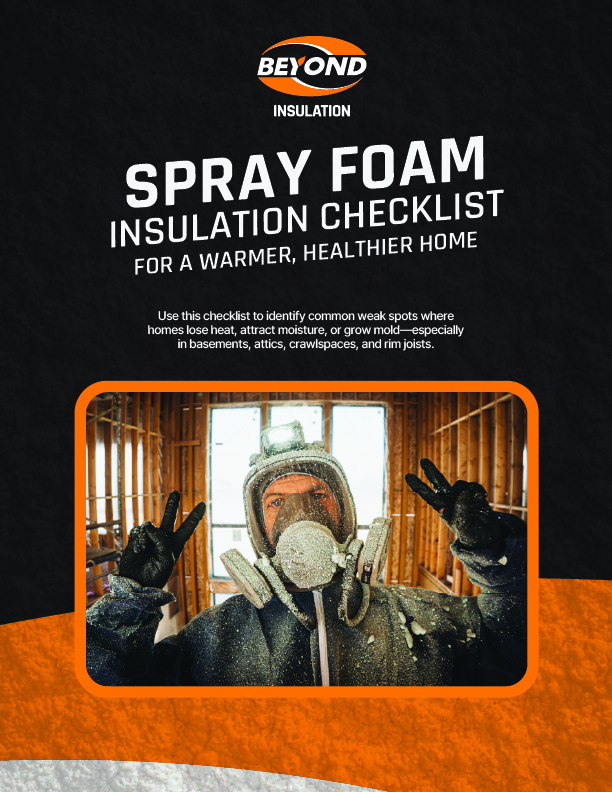Spray foam insulation is one of the most powerful solutions for improving your home’s energy efficiency, comfort, and moisture resistance. But with great power comes... a whole lot of misinformation.
We’ve seen it all: homeowners misled by low-budget contractors, jobs that weren’t up to code, and families forced out of their homes because of improper curing or lingering smells.
In this post, we’re cutting through the noise.
Whether you're insulating your attic, rim joists, basement walls, cantilevers, or crawlspaces, this guide will show you how spray foam really works, where it shines, and what you need to look out for when hiring a contractor.
Why Homeowners Love Spray Foam (When It’s Done Right)
Spray foam insulation creates an airtight seal, offers one of the highest R-values per inch, and resists moisture and mold better than almost any other product. It’s especially effective in areas where traditional insulation fails—like:
- Rim joists and cantilevers
- Crawlspaces
- Cold floors above garages
- Basement foundation walls
- Attics with irregular framing or air leaks
But here’s the catch: none of that matters if the job isn’t done exactly right.
When installed incorrectly, spray foam can:
- Trap moisture and cause rot
- Fail to bond properly to cold or damp surfaces
- Off-gas for days due to improper mixing or ventilation
- Settle or shrink, reducing its performance
And once it’s in, it’s not easy to undo. That’s why installer skill and quality control are everything.
Common Spray Foam Myths (and the Truth)
1. “It’s too expensive.”
Yes, spray foam has a higher upfront cost—but it’s a long-term investment. It seals and insulates in one step, often eliminating the need for vapour barriers, studs, or additional air sealing. Plus, it lasts for decades with no sagging, mold, or rework.
2. “It smells bad or isn’t safe.”
Only if it’s installed poorly. Properly mixed and cured spray foam is safe and odor-free after 24 hours. We follow CAN/ULC-S705.2 protocols to ensure it’s installed in safe conditions and vented properly.
3. “You can use it anywhere.”
Not always. For example, injecting foam into closed wall cavities isn’t always effective unless designed for retrofit use. That’s why we always inspect before recommending a solution.
The 6 Hidden Zones That Are Costing You Comfort & Money
Here’s where spray foam insulation really pays off:
1. Basement/Foundation Walls
Cold, damp basements are often under-insulated or using outdated materials. Closed-cell spray foam acts as both a vapor barrier and insulation, keeping your foundation dry and your floors warmer.
2. Cantilevers & Overhangs
If you have rooms that jut out past your foundation, those overhangs are often cold spots. Spray foam seals every inch of the cavity—something batts can’t do.
3. Rim Joists
The space where your floor meets the foundation is a major source of drafts. Spray foam insulation here creates an airtight barrier that traditional materials can’t replicate.
4. Crawlspaces
Spray foam turns damp, mold-prone crawlspaces into dry, conditioned spaces. It keeps out pests, seals air leaks, and stops ground moisture.
5. Rooms Above Garages
If the room above your garage is always freezing, the problem is probably poor insulation in the garage ceiling. Spray foam fixes that by sealing the entire cavity and preventing heat transfer.
6. Attics
An under-insulated attic is a money pit. We check insulation depth, air leaks, vapor barriers, bath fan connections, and attic hatches to see where spray foam might be needed for sealing or top-up.
Our 7-Point Spray Foam Inspection Checklist
Before we ever recommend spray foam, we perform a comprehensive 7-point home insulation check to see what’s really going on.
We look at:
- Insulation Type & R-Value – Is your insulation doing its job?
- Vapor Barrier Condition – Are you protected against moisture?
- Moisture / Mold Evidence – Signs of leaks, condensation, or mold growth
- Exhaust Ventilation – Are bathroom and kitchen fans vented properly?
- Intake Ventilation – Is your attic or crawlspace breathing as it should?
- Bath Fan / HVAC Connections – Any ducting issues or misrouted exhaust?
- Attic Hatch / Rim Joist Sealing – Are key air leak points properly closed off?
This process helps us educate homeowners on where their home is vulnerable and what their best insulation options are—whether it’s spray foam or something else.
What to Ask Any Spray Foam Contractor
Before hiring anyone, ask them these questions:
- Are your installers certified under CAN/ULC-S705.2?
- Do you test every job site for density, adhesion, and temperature?
- Do you keep daily install logs and photographs for quality assurance?
- What warranty do you offer?
- Do I need to vacate the home—and for how long?
If they stumble or sidestep these, run.
Our Promise: Done Right or We Make It Right
At Beyond Insulation, our work is backed by a Limited Lifetime Warranty. Every job is installed by certified technicians, tested, documented, and reviewed. If there’s ever an issue due to installation or product failure—we fix it.
Our team isn’t here to pressure you into a sale. We’re here to educate you on what’s really happening inside your home, and help you make the best, most informed decision.
Want to know what’s going on in your basement, attic, or crawlspace?
Download your Free 7-Point Home Insulation Checklist today.
Click here to schedule → [Insert link to booking page]


